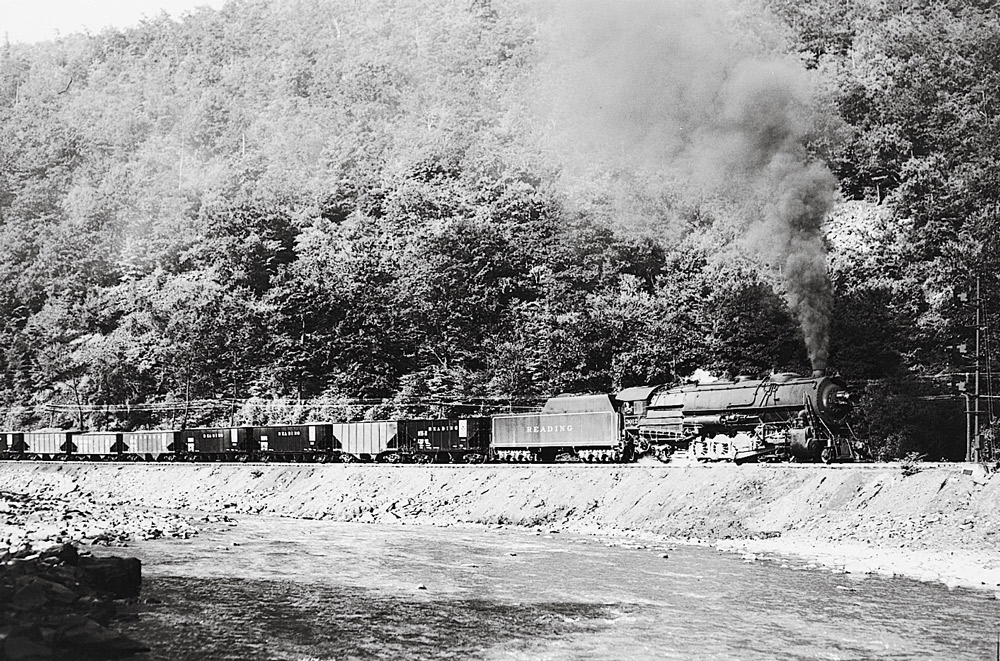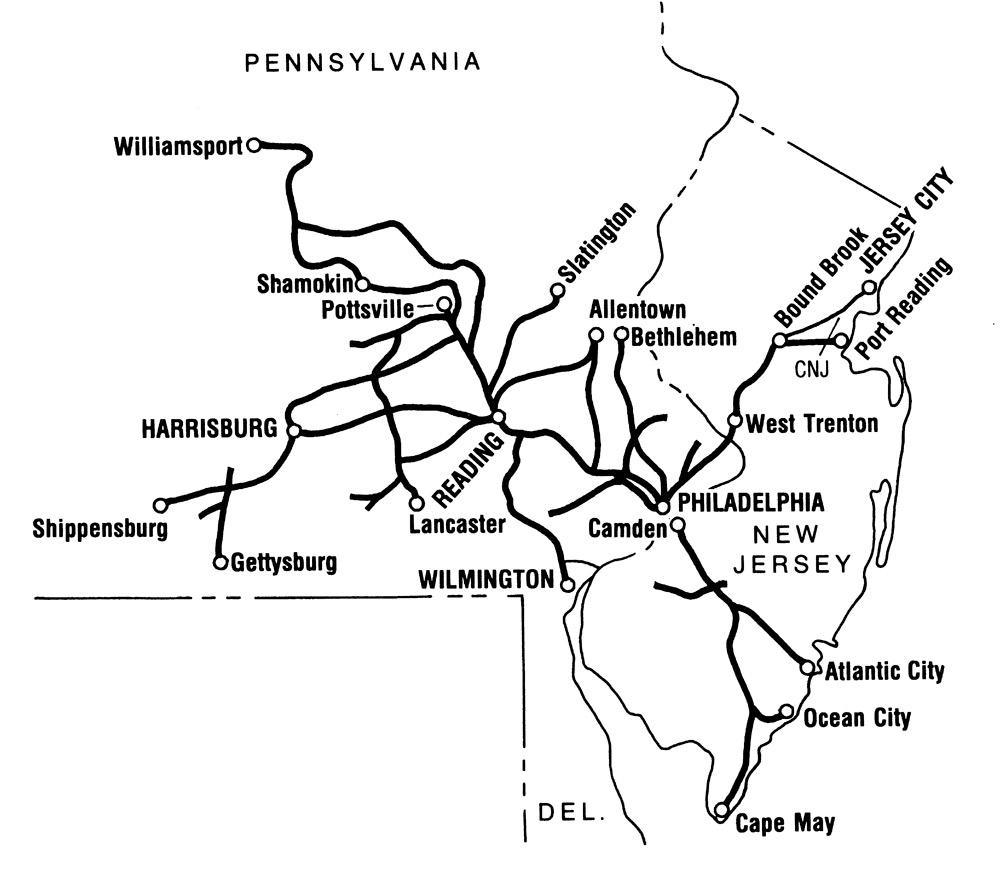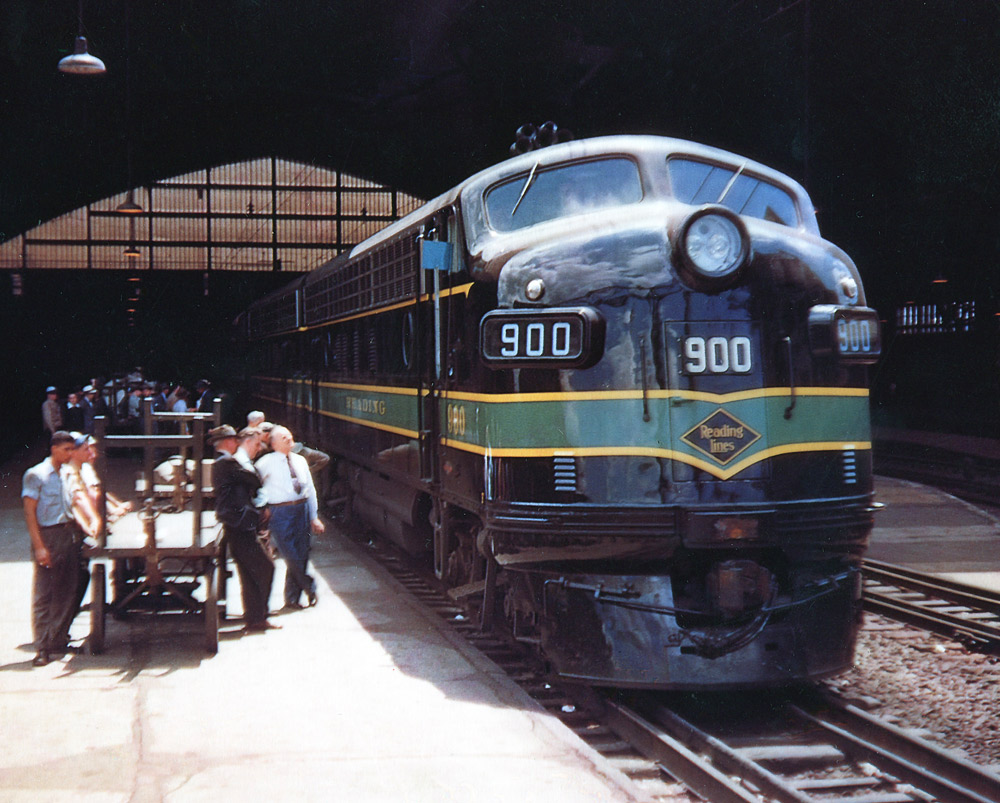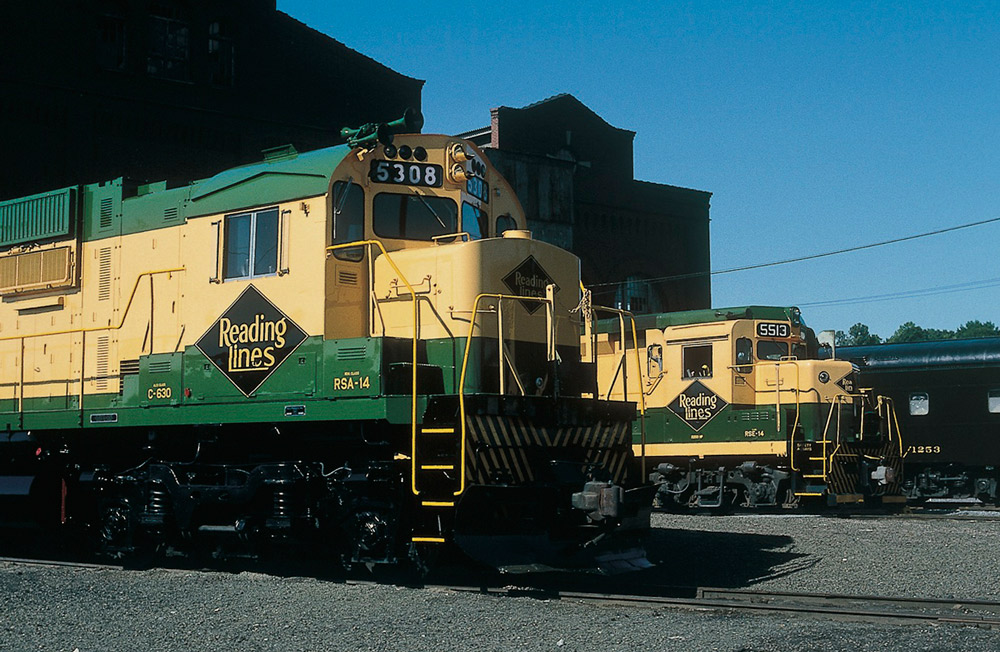Reading Railroad + Yellow Green Headlight 1938 Popular Science

Classic Trains drove
Reading Company, as a railroad, disappeared into Conrail more than xl years agone. But it is however possible to "take a ride on the Reading." This can be washed when playing the board game Monopoly, or (more than literally) by boarding a Southeastern Pennsylvania Transportation Authority driver train in the Philadelphia expanse. Today, the Reading (pronounced "Redding") would be termed a regional carrier, just in the classic era, it had a much larger presence on the railroad scene than its approximately ane,300 route-mile would suggest.
Reading Company history
The Philadelphia & Reading Railroad was chartered in 1833 and opened in 1842 from Philadelphia along the Schuylkill River through Reading to Pottsville, Pa., 93 miles. Its purpose was to booty black coal to Philadelphia. Outset in 1850, the railroad grew by leasing, purchasing, or merging with nearly 100 smaller railroads over the adjacent century. Some of the more of import were the Lebanon Valley, which gave the Reading access to Harrisburg, and the Philadelphia, Harrisburg & Pittsburgh, which extended its reach west to Shippensburg, Pa., and a connection with the Western Maryland. To the east the P&R acquired the Due east Pennsylvania Railroad between Reading and Allentown. These later routes would grade a part of the famous "Alphabet Route" from Chicago to New York and New England. Other carriers associated with this route were Nickel Plate, Wheeling & Lake Erie, Pittsburgh & West Virginia, Central of New Bailiwick of jersey, Lehigh & Hudson River, and New Haven.

Expanding north and northeast
In the late 1880s, the Reading caused the North Pennsylvania and the Delaware & Spring Brook railroads, which provided access to Bethlehem, Pa., and to a Bailiwick of jersey Cardinal connection at Bound Brook, North.J. The inclusion of several small-scale lines in the coal regions gave the Reading access to Williamsport, Pa., and an important connection with the New York Central. Eventually the Reading reached New York Harbor at Port Reading, Northward.J. As a consequence of these acquisitions, the Reading would become a strategic "bridge line," forwarding overhead traffic. (In a loftier-contour example of this part, Reading Visitor was middleman on the Jersey City–Washington Royal Blue Route.)
At Philadelphia, ferries crossed the Delaware River, assuasive the road to attain southern New Jersey seashore resorts via the Atlantic Urban center Railroad. Ane other important link was the Wilmington & Northern, which gave the route access to Wilmington, Del. In 1923, the P&R merged the companies it caused into the Reading Company and divested itself of the Philadelphia & Reading Coal & Fe Co. following a government antitrust suit. In 1933, the Reading and the Pennsylvania Railroad consolidated their South Jersey operations into the Pennsylvania-Reading Seashore Lines.

Robert J. Linden, Dale W. Woodland drove
Demise of the Reading Company
After World State of war Ii, the Reading was affected past several factors which would pb to its demise. The biggest was the decline of anthracite traffic, which went from 16 million tons in 1945 to less than 2 million in 1975. The completion of the St. Lawrence Seaway in 1957 diverted grain traffic leap for Atlantic Declension ports. The expansion of the Interstate highway system, the Penn Central merger of 1968, the demise of interchange partner CNJ in 1971, and the sale of Reading's stock by parent Chessie System led to bankruptcy in 1971. The biggest accident was the PC merger, considering information technology removed much of the bridge traffic with NYC and New Haven, traffic the Reading badly needed to make up for the loss of coal business.
On April ane, 1976, most of the Reading's railroad assets were transferred to Conrail. With Amtrak charging loftier freight user fees on its one-time PC lines, Conrail shifted much of its New Jersey and southeastern Pennsylvania freight traffic to one-time Reading lines. SEPTA continued to operate the former Reading driver routes, which Reading electrified in 1931. During the Conrail era, some 22 short lines operated portions of sometime RDG branches, but major thou and terminal facilities such every bit Port Richmond, Rutherford Yard about Harrisburg, and the Reading (Pa.) shops were downgraded. The famous 1893 Reading Terminal in Philadelphia survived inside the Pennsylvania Convention Center along with the venerable farmers' market at street level.

Robert Southward. McGonigal
Notable Reading achievements
The Reading was notable for many things. Information technology was the first to apply the "End, Look & Listen" crossbucks at road crossings. Since information technology served a large Pennsylvania Dutch (German) population, its rider-railroad train conductors were famous for beingness bilingual. In the heart of the 20th century, Reading boasted that its Port Richmond on the Delaware River in Philadelphia was the largest privately endemic tidewater port on the Due east Coast. The stainless-steel Crusader of 1937, the kickoff full-sized streamliner in the East, featured an observation car at each cease to preclude turning at its terminals of Philadelphia and Jersey Urban center.
After the steam era, the "Fe Horse Constitutional" excursions, pulled by T-1 4-8-4 steam locomotives built in the road's ain shops in 1945–48, fabricated the Reading well known all over the U.Due south. In the mid-1960s, Reading introduced its innovative "Bee Line Service." A shipper could gild a train of upwardly to xx cars to operate from point to bespeak with one crew. This fast service, blurbed on some of the Reading'south yellow-and-green high-horsepower diesels, was designed to compete with trucks for short-haul traffic.
Reading's locomotives were unique in both the steam and diesel fuel eras. The Camelback and conventional end-cab steam locomotives had wide Wootten fireboxes, above-middle headlights, and arched cab windows, giving them a distinctive await. In 1948, the Reading built the last Pacifics in the U.Due south. In the diesel era, Reading's roster boasted a corking variety with box-cabs, route-switchers, and cab units, represented past five major builders. Reading had the start GP30s and the but SD45s with built-out windshields for dual controls. What actually set most of Reading diesel fuel apart was the inverted Vshaped drip strip above the cab side windows, a feature not found on any other U.Southward. railroad except stepchild PRSL.
Reading Company's legacy today
Today, Norfolk Southern operates former Reading lines linking Philadelphia, Harrisburg, and Allentown, while CSX Transportation runs the former Reading betwixt Philadelphia and Bound Brook. Almost of the remaining Philadelphia-area lines are part of the Conrail Shared Avails functioning, and many former Reading branches are run by brusk lines. The largest cluster of these is the coal-region lines of the Reading & Northern Railroad. Much Reading equipment has been preserved at the Railroad Museum of Pennsylvania at Strasburg, and by the Reading Visitor Technical and Historical Social club at Hamburg, Pa.
greenalacertut1954.blogspot.com
Source: https://www.trains.com/ctr/railroads/fallen-flags/reading-company-a-railroad-history/
0 Response to "Reading Railroad + Yellow Green Headlight 1938 Popular Science"
Post a Comment